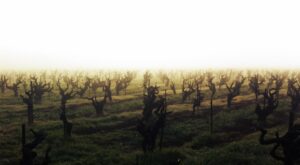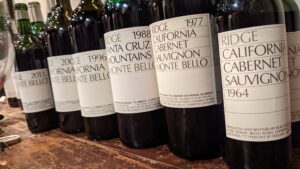While the California wine industry was moving towards a more technical approach, a group of men who desperately wanted to connect with nature decided to throw themselves into making wine in California during the early 1960s. They had heard about a legendary vineyard on the Monte Bello Ridge high up in the Santa Cruz Mountains, part of the Central Coast of California, an area planted with vines since the 1870s that piqued their interest. The Monte Bello cool climate Cabernet Sauvignon vineyards, planted on terraced slopes with limestone soil, with temperatures moderated by the Pacific Ocean and high altitudes up to 2,700 feet, seemed as if it would produce elegant wines but they needed to be sure.
The men purchased a small plot within the Monte Bello estate with which they would make a quarter-barrel of wine during the 1960 and 1961 vintages and it was one of the best wines they had ever had; so, the men re-bonded the winery on their property as Ridge Vineyards in 1962. But they didn’t want to get in the way of this fantastic vineyard, and hence, they pushed back against the wine technical driving force surrounding them at the time. They were going to start a wine revolution by proving that less is more when expressing terroir. Ironically, all of these men were Stanford Research Institute engineers.
Ridge Vineyards
The founding engineers (Dave Bennion, Hew Crane, Charlie Rosen and Howard Ziedlerfirst) were able to slowly buy back various plots of the original Monte Bello estate, adding a field blend vineyard down the road dominated by Zinfandel grape vines, planted in the late 1800s, to their portfolio. They made their first Zinfandel in 1966 after their first official Monte Bello Cabernet Sauvignon in 1962.
After increasing their production to fewer than 3,000 cases a year, far from where they needed to be to make a profit, they found a winemaker, a Stanford graduate in philosophy, Paul Draper, to join their partnership. Paul is a living legend, who, from the very start, shared the low intervention, more natural approach aligned with the founding engineers’ mission. He restored the old limestone winery built into the mountainside that the first vineyard owner constructed in the 1890s and he felt that their resources needed to be put into leasing and buying top vineyard sites that would help them establish a global reputation for outstanding wines. Unlike many people with lofty goals, he was able to achieve such a feat. But making wine, in California of all places in the ’60s and ’70s, that would compete in the fine wine world yet made with natural practices, wasn’t the only revolution he started.
Ingredient Labeling
“After making my first four vintages of Monte Bello (’69, ’70, ’71, ’72) and tasting again the superb ’62 and ’64 made by the founding partners, I thought we should do something to show how few ingredients are needed to make truly fine wine,” noted Paul Draper. When Paul reached out to the federal authority that approved wine labels all those decades ago, he was told “no”; because it was not required, no one else did it and it would be confusing to customers. With federal approval in 2008, a neighboring winery in Santa Cruz Mountains had a list of ingredients on many of its wine labels, so Paul was determined that Ridge Vineyards would do the same. With Ridge’s 2011 vintage, they began to list ingredients on their labels as well as explain each ingredient on their website. Paul further explained his intentions, “As more of our estate vineyards were certified organic and we could put “organically grown” on the label, we began to ask ourselves, does “organic” mean anything at all for your health if chemical additives were used once the grapes reached the winery?”
Ridge Vineyards is also atypical for a medium-sized winery as they have had their own lab since 1971, as most wineries back then had their analysis done by outside wine laboratories. Today’s head winemaker and COO of Ridge, John Olney, talked about how over the past several decades, Ridge has built a sophisticated laboratory that helps to complement their hands-off approach in their winery as it allows for natural fermentation, lower levels of sulfites and the minimum amount of invention during the winemaking practices by making sure that the wine is always in a stable state during each stage.
Of course, this does not mean that those who are not using ingredient labeling should be accused of using undesirable additives as, for some, it is a cost that they cannot take on, or many producers find it could create fear and confusion of listing natural additives in tiny quantities that are misunderstood by the public; such as small amounts of sulfur in wine that is much lower than many of the food products that people eat daily. Yet one thing is for sure, Ridge gives a pure expression of their vineyards that deserve nothing less as the fruit is stunning.
Motive: Marketing or Philosophy
Today, it has become trendy for relatively new, big-brand wines to list their ingredients, giving the impression that they are made of purer ingredients that are better for the consumer than most other wines on the market. This is a very dangerous marketing campaign because it maligns other wine producers who have decided to focus on their vineyards, history and philosophy instead of an ingredient list and just simply saying that there are grapes in the wine and not much else doesn’t tell a consumer the whole story of what is in that bottle.
But Ridge Vineyards, started by engineers and a philosophy major, wasn’t exactly being run by marketing experts – far from it! There is no doubt about Monte Bello having an illustrious history and sense of place that some have called America’s First Growth and Ridge is rooted in a solid commitment to avoid anything that gets in the way of wine drinkers being able to experience the true glory of their vineyards.
Paul made a valid point that putting “organic” on a wine label seemed pointless if one didn’t know the ingredients in the bottle. But what is remarkable is that many fine wine connoisseurs worldwide love the Ridge Vineyards wines and their hearts skip a beat when Monte Bello comes to the table – and some have no idea of their commitment to low-intervention winemaking and ingredient labeling. His philosophy in showing the world what is in the bottle, unadulterated, is to stand behind the greatness of his vineyards. And 60 years after the first official vintage of Ridge Vineyards, it is finally getting wider recognition for being one of the first to push for complete transparency in the wine world.
***Link to original article on Forbes: https://www.forbes.com/sites/cathrinetodd/2022/11/30/the-california-wine-revolution-natural-practices-for-fine-wine-celebrates-60th-anniversary/
60th Anniversary Ridge Vineyards Tasting:
David Gates, senior vice president of vineyard operations, said that they only make a small quantity of Monte Bello Chardonnay in certain vintages. When it comes to the difference between the Estate Chardonnay and the Monte Bello Chardonnay, the Monte Bello is a parcel and barrel selection of the best Estate Chardonnay.
2012 Ridge Vineyards, Monte Bello Chardonnay: Ripe golden apples and honeysuckle with a smoky minerality with hints of nutmeg with good concentration balanced by a nimble energy.
2006 Ridge Vineyards, Monte Bello Chardonnay: Lots of chalky minerality right off the bat with lemon custard and graham cracker flavors that had a creamy yet textured body with bright acidity and lots of energy on the finish.
“The founders were looking for only Cabernet Sauvignon vineyards in California in the 1960s, and instead, they found all these field blends, including Lytton Springs and Geyserville,” said John Olney, head winemaker and COO. The first Ridge Zinfandel blend was Geyserville in 1966, with a section of the vineyard containing vines more than 130 years old; the vineyard is composed of Zinfandel, Carignane, Petite Sirah and Mataro (Mourvèdre). And another iconic Zinfandel of Ridge is Lytton Springs which had its first vintage in 1972. Lytton Springs has Zinfandel vines that are over a century old and interplanted with Petite Sirah, Carignane, Grenache and small amount of Mataro (Mourvèdre). And despite the vineyards only being two miles apart, the Geyserville “has a little firmer acidity, more red fruit, rounder, more forward” than the Lytton Springs, according to John Olney.
2005 Ridge Vineyards, Geyserville from 3-Liter bottle: An open and generous nose with lush red cherries and baking spices intermixed with star anise and a gracefully broad body with fleshy fruit that has lots of energy on the finish.
1999 Ridge Vineyards, Geyserville from 3-Liter: Broken earth with subtle hints of raspberries and rhubarb with white pepper and poppy seeds and silky tannins and refreshing acidity.
2005 Ridge Vineyards, Lytton Springs from 3-Liter: Blackcurrant fruit with notes of licorice and dried herbs with structured tannins that give lift to the concentrated fruit.
1999 Ridge Vineyards, Lytton Springs from 3-Liter: This shows how Ridge’s Zinfandel blends can age beautifully with plenty of supple black cherry fruit with added layers of black pepper and crushed rock that has tannins with big shoulders balanced by plush black fruit on the mid-palate; a harmonious wine.

Photo Credit: Cathrine Todd
Monte Bello was initially 100% Cabernet Sauvignon until 1975, but through time Merlot, Cabernet Franc and Petit Verdot were planted as it was difficult to fully ripen the Cabernet Sauvignon decades ago in the cool climate of Santa Cruz Mountains, just like in Bordeaux, and so other Bordeaux varieties were added to bring balance. The 1964, listed as the last wine, was only 11.5% alcohol.
2013 Ridge Vineyards, Monte Bello: 80% Cabernet Sauvignon, 8% Petit Verdot, 7% Cabernet Franc and 5% Merlot. Ridge Vineyards usually re-releases their Monte Bello wines again onto the market after ten years, and so this 2013 is currently available on the market. This is a stunning wine, from the multi-faceted aromas and flavors of cassis, espresso, truffles and a stony minerality with plush texture that has firm tannins with racy acidity giving vitality to the intensely concentrated fruit along the extraordinarily long finish. Wow!
2005 Ridge Vineyards, Monte Bello from Magnum: 70% Cabernet Sauvignon, 22% Merlot, 6% Petit Verdot and 2% Cabernet Franc. Redcurrant preserves with cocoa powder and upheaved earth with hints of fresh sage and slightly firm tannins that has lots of juicy fruit on the palate.
1996 Ridge Vineyards, Monte Bello from Magnum: 80% Cabernet Sauvignon, 11% Merlot and 9% Petit Verdot. A lovely aromatic nose that is still so vibrant with boysenberry and black raspberry with allspice in the background that has intense flavors on the palate with lots of focused energy.
1988 Ridge Vineyards, Monte Bello from Magnum: John Olney said that this wine does have a bit of Brettanomyces (Brett) as it was a learning process of how to work naturally without unwanted yeasts converting into sometimes off-putting aromas during fermentation. But Brett can range in qualities from barnyard to gamey notes and this wine has a hint of grilled pork ribs, which is an aroma loved by some people and so the Brett may not be an issue for some, adding layers of smoldering earth, brambly fruit and tree bark with a textured body.
1977 Ridge Vineyards, Monte Bello from Magnum: Smoky note that is reminiscent of lit charcoal, wild berries and graphite with blueberry scones and bacon fat with a linear body with fierce energy and lift on the finish.
1964 Ridge Vineyards, Monte Bello: 100% Cabernet Sauvignon. Fresh tobacco leaf and hints of tar with layers of sandalwood, cigar box and forest floor in the background that has well-integrated tannins and marked acidity, giving a mouthwatering finish.














